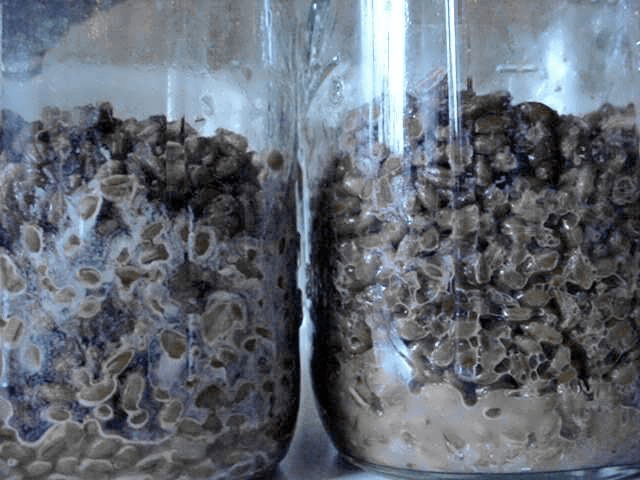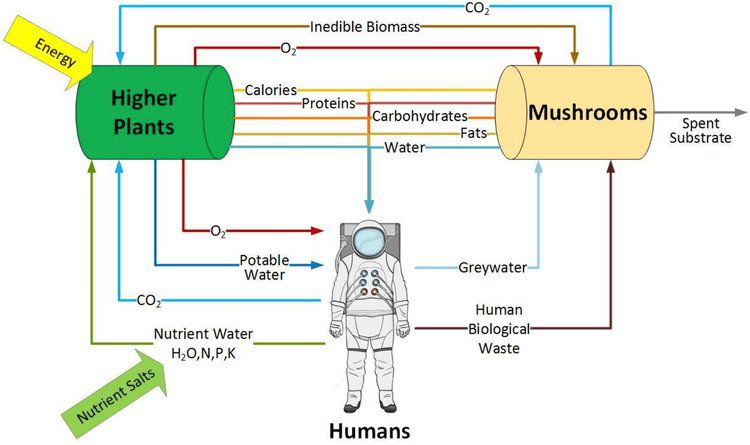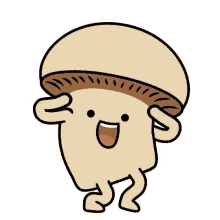Jul 25, 2022
The 8 Most Popular Mushroom Cultivation Techniques For Commercial Growers & Amateur Mycologists

Exotic mushrooms grown in an arts studio for Netflix's Fantastic Fungi documentary; GIF sourced from Moving Art & WIRED.

Mushrooms fruiting on Mt. Lemmon in Arizona, during the monsoon season in 2019. Foraged by Dr. Barry Pryor.
Written By: Justin Hyunjae Chung
Editor’s Note: This is an investigative article from Agritecture’s Agriculture Technologist on the core principles of and primary techniques for mushroom cultivation. Justin’s professional experience in the topic is supported by his Master’s in Biosystems Engineering from the University of Arizona’s Controlled Environment Agriculture Center (CEAC), where his thesis revolved around vertical farming and specialty mushroom cultivation. Learn more about mushroom cultivation in Justin’s last article.
Neither plant-like nor animal-like, mushrooms are ancient and non-photosynthetic organisms that belong to their own kingdom: Fungi.

The Fungal kingdom is said to be one of the most diverse groups of organisms on Earth. Here’s the fundamental life cycle of a mushroom. Image sourced from North Spore.
In order to better understand mushroom cultivation as it relates to controlled environment agriculture (CEA), it is crucial to first gain a better understanding of the fungal kingdom and the fungal life cycle.
The primary role of fungi in the ecosystem is decomposition, or scavenging for dead and decaying organic matter and regenerating it back into organic life. In short, fungi are the “recyclers'' of the natural world.
The fungal life cycle starts when “spores” land on a suitable substrate and propagate to form “hyphae”. When two sexually compatible hyphae fuse together, they form dikaryotic (two nuclei) “mycelium,” which is the root-like structure of fungi that is responsible for secreting digestive enzymes externally to break down its substrate. After digesting the substrate and under the right environmental conditions, the mycelium forms “primordia” that eventually enlarges to become a fruiting body known as the “mushroom.” At full maturity, the mushroom caps “sporulate” and release spores back into the environment, thus allowing the cycle to repeat itself.
Mushroom cultivation is the art and science of harnessing mycelium, the root-like structure of fungi, to promote the growth of mushroom fruiting bodies.
Numerous techniques (referred in the mycology community as “TEK”s) are commonly used to achieve this desired outcome, ranging from trays, logs, bags, bottles, buckets, tubs, and more. There is no set regimen to growing mushrooms as it is the co-evolution/merger between humans and fungi which manifests itself in many unique ways.
This said, the core principles remain the same. The mushroom cultivator is harnessing the growth of mycelium, the workhorse of the fungal organism, by feeding it the right amount of nutrients with the right timing, akin to a surfer riding a wave as it crests.
After mycelium (agar tissue, liquid culture, grain spawn) is ‘inoculated’ onto a pasteurized or sterile substrate, the mycelium ‘colonizes’ the substrate by secreting digestive enzymes to break down the lignin, cellulose, and hemicellulose of the substrate. After full colonization, the mycelium produces ‘pins’ that eventually become mushrooms under the right conditions.
The fruiting conditions should mimic how mushrooms develop in nature, which is the right mixture of temperature, humidity, CO2, airflow, and lighting.
In the growing environment, the “invisible enemy” is contamination, particularly in the early stages of growth, as unwanted competition from airborne spores or bacteria can compete for the same resources. Contamination management is analogous to integrated pest management (IPM) for vertical farms and greenhouses.

Trichoderma mold growing on agar in a petri dish. The forest green color shows how the mold can turn white and yellow as the infection spreads. Image sourced from Benpol / Shutterstock.

Bacillus, commonly known as “wet spot” due to making uncolonized grain spawn appear excessively wet, carries a strong foul odor that has been described as smelling like rotting apples. Image sourced from PsilosOpediuM.
The main operational tasks for growers are substrate preparation, pasteurization / sterilization, sterile transfers / inoculations, fruiting, harvesting, disposal, and cleaning. Each mushroom cultivator will have their own equipment to accomplish these tasks, while also coming up with strategies for energy, water, and waste management.
Mushrooms, and more broadly Fungi, serve as the nexus point for climate-adaptation, regeneration, and resilience.

A system level diagram of higher plants and mushrooms BLSS. Diagram sourced from Sean Gellenbeck’s research paper Mushrooms on Mars.
My own version of a circular agricultural system would include mushroom cultivation at the center, branching out to insect production, aquaculture, animal feed, plants, and other forms of organic waste management.
For long duration manned missions to the Moon and Mars, my colleague Sean Gellenbeck’s research paper titled Mushrooms on Mars highlights the value of fungi in Bioregenerative Life Support Systems (BLSS). Perhaps fungi have the ability to aid humanity in terraforming Mars in mysterious ways.
As humanity enters into a period of resource depletion and buildup of toxic waste, allying with the fungal kingdom could be our solution to achieve a new equilibrium within our own spaceship - Earth.
Here are eight primary techniques for commercial mushroom operations:

Tray Culture
Used to mass-produce Agaricus (button, cremini, portobello) mushrooms, this method of growing accounts for over 90% of the total market share in the US. This method can be highly mechanized (filling, spawning, casing), but is limited to certain species and substrate combinations. Trays are usually best suited for coprophilous (dung-loving) fungi that are naturally found in soils enriched with dung and on compost piles.
*Image: The US is the world’s second largest Agaricus bisporus producer; Image sourced from Small Business Trends.

Bag Culture
Bag culture is an inexpensive method that gives the mushroom cultivator great flexibility (species/substrate combinations) with minimal contamination. This method is appropriate for distributed farming as the entire growing process does not need to occur in a single location. Commonly used for specialty/exotic mushroom cultivation, this method is sterilization friendly and not easily mechanized, making it a labor-intensive process.
Of course, the biggest downside is the use of single-use plastic bags. However, considering the incredible resource-use efficiency of mushroom farms in terms of land, water, and energy compared to other forms of protein production, plastic bags leave a relatively small footprint.
*Image: Pleurotus ostreatus var. columbinus (Blue Oyster mushrooms) growing on a mix of straw / cotton seed; Image sourced from Justin Hyunjae Chung, from his own experiments in the University of Arizona’s CEAC Myco-culture Lab.

Log Culture
Log culture is as hyper-organic as it gets. It’s traditionally used in Asian cultures, recycles forest waste, and regenerates soil. The logs must be fresh to avoid contamination and inoculated with spawn, usually during the fall or winter.
The primary downsides are longer yield times and labor intensiveness. Furthermore, it is crucial to cut logs in a sustainable way, ideally as part of a forest thinning.
*Image: Lentinula edodes (Shiitake mushrooms) grow exceedingly well on hardwood oak tree logs; Photo by Stephen Hight, USDA.

Tubs
Tubs are an easily accessible way to grow mushrooms in the comfort of the mushroom cultivator’s home. This method requires easily accessible equipment and is best for mushrooms that grow in a tray-like fashion. It is commonly used to grow psilocybin-containing species, which is currently illegal in the US and many countries as a Schedule 1 substance.
The downsides to this method are that it is prone to contamination, allows for limited airflow, and it’s difficult to dictate the formation of the fruiting bodies, thereby limiting the practical application to a limited number of species.
*Image: Pink oyster mushrooms growing in a tub. Harder to harvest compared to growing in bags; Image sourced from Reddit user.

Bottle Culture
Think Henry Ford meets mushrooms. Bottle culture can be highly mechanized, including the inoculation process, which drastically reduces labor costs per given yield. There is also uniform mushroom growth which allows for greater consistency.
The downsides are its expensive capital costs and requirement of a reliable low-wage workforce due to the repetitive nature of tasks.
*Image: Growing recently-domesticated maitake mushrooms; Image sourced from Mycopia.

Jar Culture
Jars are easily accessible, reusable, and sterilizable equipment that is commonly used by home cultivators for making grain spawn. Because of its transparent nature, jars allow growers to peer into the mushroom growth cycle as well as discover any contamination.
The downsides are the size of the container limiting the size of mushroom fruit body growth and the labor that goes into cleaning and reusing each jar.
*Image: Cordyceps Militaris, commonly cultivated in jars, are known for increasing stamina and endurance; Image sourced from FreshCap.

Bucket Culture
This is an example of an organic farm utilizing retrofitted shipping containers to grow oyster mushrooms as supplemental income. This method is convenient, highly adaptable, and doesn’t require high startup costs.
However, this method is labor intensive, limited to a certain number of species, and requires a tedious pasteurization process.
*Image: “We chose to use HDPE pails for our mushrooms because of the minimal impact it has on the environment.” - David Proctor; Image sourced from BKW Farms.

Column Culture
Lastly, mushrooms can be grown on columns hanging from the ceiling to maximize the three dimensional space of the fruiting room. Commonly used to grow oyster mushrooms in insulated containers, column culture is very similar to bag culture in terms of the use of plastic bags.
The downsides of column culture are its use of single use plastic bags and difficulty in transporting the columns throughout the different stages of the cultivation process.
*Image: Wood Ear mushrooms growing on columns in a greenhouse in South Korea; Image sourced from Justin Hyunjae Chung, from his travels to Professor Choi's Mushroom Farm.





